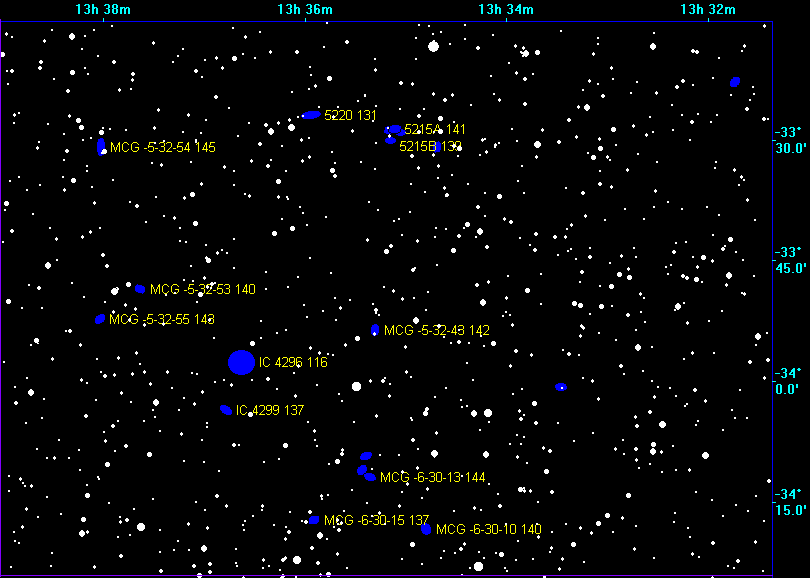
The IC 4296 group (Abell 3565) resides in northern Centaurus, just four degrees south of M83. The brightest member, IC 4296 (V = 10.6) is a giant elliptical radio galaxy and dominates the 30 or so members. Deep images reveal it is interacting with IC 4299 6' SSE. Both of these galaxies were discovered by Lewis Swift using a 16" refractor in southern California on December 30, 1897. John Herschel had earlier visited the cluster from the Cape of Good Hope in the 1830's but only picked up two fainter members, NGC 5215 and NGC 5220 (itself a close interacting pair).
If you observe this group, make sure to check out the IC 4329 cluster (Abell 3574), about four degrees northeast. At the western edge of the cluster is the interacting, distorted pair NGC 5291 and MCG -5-33-5, better known as the "Seashell" galaxy for its "whelk" like appearance. Deep photographs reveal plumes of material extending from the tidal disturbance stretching some 600,000 light years!
The following observing notes for the IC 4296 group were made on 21 April 2001 from our favorite observing site near Fiddletown, California with my 17.5" at 220x and 280x. Nine cluster members were picked up within a 50' circle.

NGC 5215A = E383-IG28 = M-05-32-040 = VV 693
13 35 06.7 -33 28 53
V = 13.1; Size 0.6x0.5; SB = 11.7; PA = 105d
17.5": western component of double system with N5215[B]. Ths member appears
faint, very small, 20", stellar nucleus. N5215[B] follows by 20".
NGC 5215B = E383-IG29 = M-05-32-041 = VV 693
13 35 09.5 -33 29 02
V = 12.9; Size 1.1x0.5; SB = 12.1; PA = 70d
17.5": this double system consists of a two faint, very small galaxies
separated by 20" E-W. The following member (described by John Herschel) is
slightly elongated. Both galaxies have sharp, stellar nuclei. A mag 14 star
lies 42" due south of the eastern component. Located 12' SE of a mag 6.5
star within Abell 3565.
ESO 383-030 = M-05-32-043 = A1332-33
13 35 17.7 -33 53 55
V = 13.2; Size 1.4x0.9; SB = 13.2; PA = 178d
17.5": very faint, small, elongated 2:1 N-S, 0.8'x0.4'. A mag 14 star is at
the south edge, 25" from the center.
ESO 383-031 = M-06-30- 013
13 35 21.3 -34 12 23
V = 13.7; Size 1.2x0.6; SB = 13.2; PA = 83d
17.5": extremely faint, small, elongated 3:2, 0.6'x0.4' E-W. Forms a pair
with E383-032 2.7' N within Abell 3565.
ESO 383-032 = PGC 47913
13 35 23.0 -34 09 40
V = 14.4; Size 0.9x0.6; SB = 13.6; PA = 108d
17.5": extremely faint, very small, round, 0.4', low surface brightness.
Forms a pair with E383-031 2.7' S.
NGC 5220 = E383-036 = MCG -5-32-46
13 35 57.0 -33 27 13
V = 12.2; Size 2.3x0.7; SB = 12.6; PA = 97d
17.5": fairly faint, moderately large, elongated 5:2 E-W, 1.5'x0.6'. A mag
13 star is at the following end [52" from center] and a mag 14.5 star is just
north of central region. A mag 9.1 star lies 2.8' SE. NGC 5215 (pair) lies
10' W. Located 17' SE of mag 6.6 HD 118010. Dust lane (similar to Sombrero)
not seen.
IC 4296 = E383-039 = M-06-30-016
13 36 39.1 -33 57 59
V = 10.6; Size 3.4x3.2; SB = 13.2
17.5": moderately bright, moderately large, at least 2' diameter, round,
bright core, stellar nucleus. Brightest in Abell 3565 and group LGG 353
(part of Centaurus-Hydra supercluster). Forms a pair with IC 4299 6' SSE.
IC 4299 = E383-042 = M-06-30-017
13 36 47.5 -34 03 58
V = 12.6; Size 1.8x0.6; SB = 12.6; PA = 58d
17.5": fairly faint, fairly small, elongated 3:2 SW-NE, 1.2'x0.8'. Moderate
concentration with a small brighter core. Located 6' SSE of IC 4296.